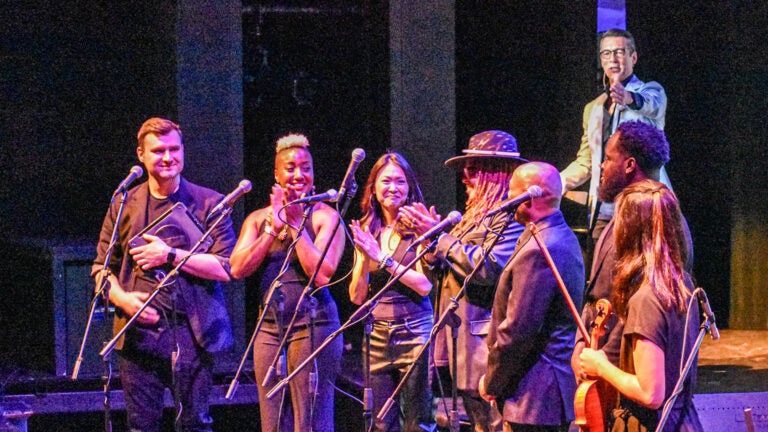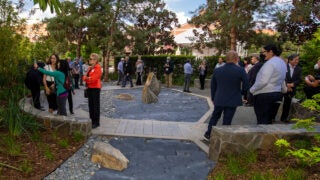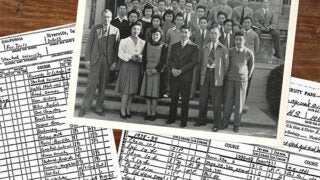
Defining Courage tells the tragic yet uplifting story of the heroic Nisei soldiers of World War II through documentary footage, old photos, eyewitness interviews and drone footage presented with musical performances and narration. (Photo/Andrew Dubbins)
‘Defining Courage’ event spotlights the uplifting yet tragic story of WWII Nisei soldiers
The audience of more than 500 includes surviving 98-year-old soldier Yoshio Nakamura, a proud double Trojan.
By the time 98-year-old World War II veteran Yoshio Nakamura arrived on the stage of USC’s Bing Theatre on Tuesday evening, many in the audience of students, faculty and community members were already in tears.
The crowd of more than 500 attendees had gathered to watch Defining Courage, a live docu-theater experience that tells the tragic yet uplifting story of the heroic Nisei soldiers of World War II through immersive storytelling that mixes documentary footage, old photos, eyewitness interviews and drone footage presented with live musical performances and live narration.
Nakamura, a double Trojan, is one of the last surviving Nisei soldiers, Americans of Japanese descent who served in segregated military units overseas during World War II. These soldiers fought for their country even as the U.S. government forced many of their family members to live in incarceration camps back home.

“Largely, Americans have never heard this story before,” the program’s narrator and co-producer David Ono said to the audience. “I love the fact that we’re here at USC, and I love the fact that there are so many young folks from the university here from various schools.”
Ono, a news anchor with Los Angeles’ KABC-TV, is Defining Courage’s producer along with filmmaker Jeff MacIntyre, the Emmy-winning USC alumnus who is also the program’s director. The pair visited sites in Italy, France and Germany where harrowing battles involving the 442nd Infantry Regiment of the U.S. Army took place to conduct interviews and shoot footage.
“You can’t fully comprehend a complex story like this by simply reading books or Googling about it,” Ono said. “We have witnesses and historians and people who have lived this story. We’ve stood on hallowed ground like the dense forests of France where remnants of the battle are everywhere and to this day untouched.”
Defining Courage, living history
Nakamura worked as a mortar specialist with the 442nd Infantry Regiment. The regiment, including the 100th Infantry Battalion, is best known as the most decorated in U.S. military history, and it is their heroics and sacrifices that are detailed in Defining Courage. The program has been performed across the country more than a dozen times in recent years, including at the John F. Kennedy Center for the Performing Arts in Washington, D.C. Tuesday marked its first presentation at a university.
“As a Trojan, anything that happens like this here at USC is a great thing for me,” Nakamura said as he was surrounded offstage by well-wishers. “David Ono and Jeff MacIntyre put together the perfect program.”

Nakamura is the recipient of a Bronze Star and the French Foreign Legion medal. All members of the 442nd, living or dead, received the Congressional Gold Medal in 2011.
Although he is now engrossed in it, Ono knew little about the 442nd and its part in American history despite his own Japanese American background and a childhood spent on military bases in Texas.
“Being a journalist, you’re a little bit ashamed that you had a blind spot to such a significant part of history,” he told the audience. “But then you start to realize that when we’re ignorant to certain things in our history, it’s not necessarily our fault. It’s what we teach, how we teach it, what we put in our history books.”
Powerful audience reactions to Defining Courage
The Bing Theatre was nearly filled to capacity, with some in the audience saying they had seen Defining Courage before.
“This is only the fourth time I’ve seen this and no matter how many times I see this, I get very emotional,” said USC alum Richard Murakami, who has been volunteering at the Japanese American National Museum for 30 years.

Oscar-nominated actor Edward James Olmos was also in attendance. He greeted Nakamura after the program and congratulated Ono.
“It was beautiful,” Olmos said in an interview. “It’s something that really, all of us should know a lot about.”
Freshman Belly Laird of the USC Kaufman School of Dance described the program as “incredible.” She watched with great interest because her grandparents were among those forced into incarceration camps.
“I’ve always known a little bit about the 442nd Infantry Regiment because I’m Yonsei [a great-grandchild of Japanese immigrants],” said Laird, who became emotional during the program. “But I never really heard the stories in depth or had this kind of overview of what happened until tonight. I think it’s really important to keep telling these stories.”
‘They were all heroes’
At the after-party held at the Amy King Dundon-Berchtold University Club of USC, audience member Dawn Satow was also emotional as she spoke about the program she had just seen. Her late father, Susumu Satow, had volunteered for the 442nd after being incarcerated for more than a year. Before the war he had played on the high school baseball team, but a month before graduation he and the rest of his family were sent to a incarceration camp in Arizona.
“It was very moving, particularly parts regarding the 442nd and what they had to go through,” she said. “I can’t imagine what they were thinking at that time or how they felt. It’s just unbelievable what they did. And they were all heroes.”
But Satow said her father “unfortunately” didn’t share many of the memories from the war with his children.
“I think they probably wanted to put it behind them,” she said. “But when he got together with all the buddies in his unit at the reunions, they would be telling stories to each other into the night.”
The performance of Defining Courage wrapped up USC’s Asian American and Pacific Islander Heritage Month events and was part of the USC Center on Public Diplomacy’s Stroum Arts and Diplomacy Series.



